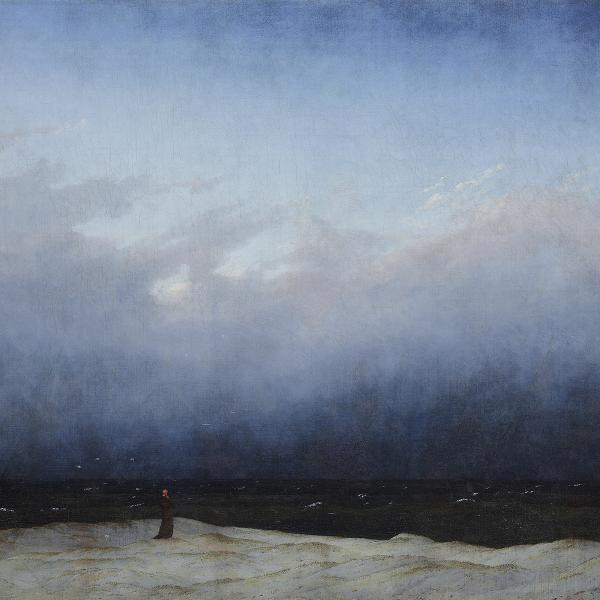Monk by the Sea
Artwork Details
- Title: Monk by the Sea
- Artist: Caspar David Friedrich (German, Greifswald 1774–1840 Dresden)
- Date: 1808–10
- Medium: Oil on canvas
- Dimensions: 43 5/16 × 67 1/2 in. (110 × 171.5 cm)
Framed: 50 9/16 in. × 74 7/16 in. × 4 3/4 in. (128.5 × 189 × 12 cm) - Classification: Paintings
- Credit Line: Nationalgalerie, Staatliche Museen zu Berlin (NG 9/85)
- Curatorial Department: European Paintings
Audio

373. Monk by the Sea, 1808–10
“These paintings confront me, rather than the other way around.”
NARRATOR: One of Friedrich's most celebrated paintings is Monk by the Sea, painted between 1808 and 1810. When it was first displayed, it both impressed and challenged viewers with its emptiness and vastness.
ALISON HOKANSON: You have the thin strip of beach and you have the monk and the thin strip of water and this enormous sky. And the sky blends into the water so that you almost can’t tell where the horizon is.
NARRATOR: Co-curator, Alison Hokanson.
HOKANSON: We know from technical analysis that originally Friedrich had ships on the water. And so, originally the monk was gazing out at ships on the sea, but before that painting was exhibited, Friedrich elected to paint them out.
That is precisely what makes that painting so radical in its ambitions is its absence of anything for the monk to look at except for the horizon. Except for infinity.
JOANNA SHEERS SEIDENSTEIN: Later in his life, Friedrich reflects and one of the most memorable things he says is that you can’t force too much into a work of art.
NARRATOR: Co-curator, Joanna Sheers Seidenstein.
SHEERS SEIDENSTEIN: And when you look at the monk, you sort of see that, right? That space is there. It's so powerful precisely because of that.
JORDAN B. COOPER: What I particularly love about this is that the colors of the monk here match the colors of nature.
NARRATOR: Lutheran pastor, Jordan B. Cooper.
COOPER: So, there is also this unity at the same time with creation. And then you just see the little color of the head that also then creates this contrast, as small as it is.
How does the human person relate to the vastness of nature? These paintings confront me rather than the other way around. The mysteries of life and of nature and, yeah, the terrors of life and of nature, but God's presence that comforts and guides in the midst of that.
HOKANSON: This painting, it’s a creative process. He's painting as a way of deriving, creating meaning. The resulting painting is incredibly radical because it evokes the infinite, it evokes this kind of existential uncertainty, and it does it in an incredibly minimal way.
COOPER: I actually have this up in my living room. I just love this painting. It’s this constant reminder of my own finitude and the infinite nature of the God who has chosen to reveal himself.
###
Music: Beethoven, Piano Sonata No.14 in C-Sharp Minor, Op. 272, Moonlight Sonata